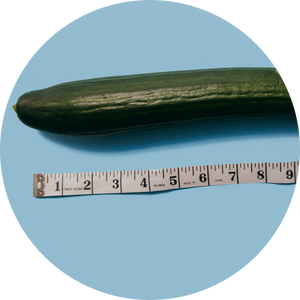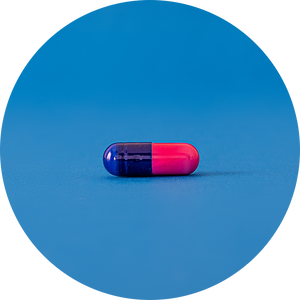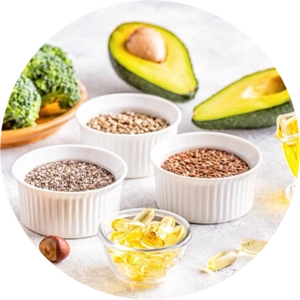Losing excess weight and keeping it off is generally a great way to improve overall health and reduce the odds of issues including erectile dysfunction (we’re a men’s telehealth company after all).
One way to lose weight and get healthier is to change your nutrition and diet.
Many dietary guidelines over the last few decades have placed emphasis on cutting back on fat. But your body does need fat to function, and more approaches to dietary health these days are keeping (and even adding) fats.
Instead of eliminating fat from your diet, it may make sense to focus on eating healthy fats in moderation, like polyunsaturated fat.
What Is Polyunsaturated Fat?
Four types of fat are found in the food you eat. Of the four types of fat, two are generally considered "healthy", and two are widely considered "unhealthy."
Polyunsaturated fats are considered one of the healthy ones. You can find polyunsaturated fats in many foods, but fatty fish like salmon and cod have an especially high fat content. In particular, these foods are full of omega-3 fatty acids and omega-6 fatty acids.
What Are the Benefits of Polyunsaturated Fat?
The most significant benefit of eating foods high in polyunsaturated fat is that it can lower your cholesterol levels. Two types of cholesterol are found in your blood: low-density lipoprotein (LDL) and high-density lipoprotein (HDL).
LDL is generally considered a "bad" cholesterol, and high levels are a risk factor in your odds of heart disease, stroke, and heart attack.
HDL cholesterol is considered a "good" cholesterol because it absorbs LDL cholesterol and returns it to the liver.
Polyunsaturated fats help increase good cholesterol and decrease bad cholesterol. These are a few of the other benefits provided by polyunsaturated fats:
- Aid in cell growth and build cell membranes and nerve coverings
- Helps with blood clotting
- Can lower inflammation
- Plays a role in muscle movement
- Reduces the triglycerides in your blood
- Lowers the risk of an irregular heartbeat
- Supports brain development and function
- May support brain function and prevent cognitive decline and dementia
- Helps prevent plaque build ups in your arteries
- Helps reduce the risk of coronary heart disease
- Can help lower blood pressure
- Reduces the odds of diabetes
- Improves your ability to control blood sugar
Which Foods Have the Most Polyunsaturated Fats?
There are traces of polyunsaturated fats found in all kinds of foods. The trick is to focus on foods with the highest omega-3 or omega-6 content and the lowest amount of total fat. These particular fatty acids are essential to a healthy and balanced diet.
Omega-3s are plentiful in nuts and seeds such as flaxseed, chia seeds, walnuts, sunflower seeds, and pine nuts. However, the primary sources of omega-3s in the human diet are from certain types of fish. Mackerel, salmon, tuna, sardines, and cod are known as fatty fish that are packed with the most omega-3s.
Omega-6 is mainly found in oils. Safflower oil, canola oil, sunflower oil, poppy seed oil, and soybean oil have the highest concentrations of omega-6s. You can also find omega-6s in tofu, meat, soybeans, poultry, fish, and eggs.
You generally get a normal amount of omega-6 without even trying if you’re eating a standard American diet, so try to shift your focus to getting more omega-3s.
Are There Risks to Eating Polyunsaturated Fat?
Every type of fat that you eat contains nine calories per gram. That’s more than twice the calories per gram of carbohydrates and protein. Eating foods that have a ton of fat can quickly rack up the calories, regardless of whether it's a healthy macronutrient or not. The relationship between the omega fatty acids is complicated and can disrupt your health if you don’t watch which ones you eat and how much.
Omega-3 fats have anti-inflammatory properties that can aid in reducing inflammation. On the other hand, omega-6 fats can contribute to inflammation. That’s not necessarily a bad thing, as your immune system uses this response for a few purposes. It can help to fight off infections and heal wounds and injuries, but systemic inflammation can contribute to obesity, diabetes, heart disease, and even lower testosterone production.
What Are the Other Types of Fat?
Each type of fat has a unique chemical composition, and the way molecules in a fatty acid chain come together can significantly alter their nutritional value.
The type and total number of chemical bonds found in fats put them into four categories:
- Polyunsaturated fats contain two or more double bonds in their chemical structure. As mentioned earlier, these fats can be found naturally in some vegetable oils and most seafood, especially fatty fish. Consuming polyunsaturated fat can help to increase HDL levels (good cholesterol) and decrease LDL levels (bad cholesterol).
- Monounsaturated fats contain exactly one double bond in their chemical structure. These fats are found in nuts, seeds, and avocados but mainly come from cooking oils like canola oil, peanut oil, or olive oil. Consuming monounsaturated fat may provide the same effect on cholesterol as polyunsaturated fat in healthy people.
- Saturated fats contain zero double bonds in their chemical structure. Foods high in saturated fat stay solid at room temperature, where unsaturated fats become a liquid. Saturated fat is in almost all animal products, including meat and dairy. Red meat is especially high in saturated fat compared to poultry and seafood. Saturated fats can increase LDL cholesterol, contribute to weight gain, and may also contribute to heart disease and other health conditions.
- Trans fats are created through a process called hydrogenation. They typically start as unsaturated fat before hydrogen atoms eliminate their double bonds. The process helps turn traditionally healthier fats into solids and extend their shelf life. Trans fats are in processed food, baked goods, and fried foods. There are no known health benefits to trans fat (in fact, it’s really just bad for you), and you should try to reduce trans fat intake as much as possible.
How Much Fat Should You Eat Daily?
Most dietary guidelines suggest between 20 to 35 percent of your daily calories should be fat. Eating less fat may help you lose weight, but it doesn’t necessarily mean that it’s good for your health. Instead of reducing fat intake, pay more attention to the type of fat you eat, as well as where the rest of your calories come from.
Unsaturated fats provide the essentials you need from fat and can help to improve health in the process.
Saturated and trans fats are those that you need to keep an eye on. Most professionals will recommend keeping saturated fat intake to less than 10 percent of your daily calories. Trans fat is not natural and is easier to avoid. Be mindful of the trans fat content when eating frozen or processed foods and limit fried foots to occasional treats.
The Takeaway
Polyunsaturated fat is broadly considered one of the "healthy" fats that most people could include more of in their diet. Trans fats like those plentiful in processed foods are widely considered unhealthy and a contributing factor to the spread of obesity and metabolic conditions in Americans today.
Losing weight is a challenge and may only get more challenging as you age. Following a fad diet might help you shed some extra pounds, but you’ll need to make permanent lifestyle changes to keep the weight off. And, losing weight isn't always the only goal when you change your diet.
The fat content in your food plays a key role in your health. Replacing fats in your diet with polyunsaturated and monounsaturated fats can reduce cholesterol levels and may help you lose weight.
SOURCES
Healthy Fat Intake | Cleveland Clinic
Hydrogenation of Unsaturated Fats and Trans Fat | Chemistry Libre Texts
Eating red meat daily triples heart disease-related chemical | National Institutes of Health
Effect of a diet enriched with monounsaturated or polyunsaturated fatty acids | Pubmed
Types of Fats | Michigan Medicine
Fat and Calories: The Difference & Recommended Intake | Cleveland Clinic
Dietary intakes and food sources of omega-6 and omega-3 polyunsaturated fatty acids | Pubmed
Facts about polyunsaturated fats | MedlinePlus Medical Encyclopedia
Polyunsaturated Fat | American Heart Association
Polyunsaturated fatty acids and their effects on cardiovascular disease | NCBI
The truth about fats: the good, the bad, and the in-between | Harvard Health












